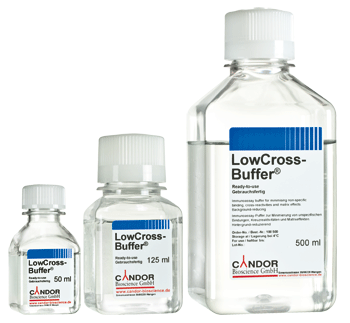LowCross-Buffer®
Antibody and sample diluent for minimizing nonspecific binding, cross-reactivities and matrix effects in immunoassays
The formulation of LowCross-Buffer® helps to reduce interference in immunoassays. Thus quality of detection can be significantly improved. Nonspecific binding of the antibodies, negative effects of interfering substances and low or medium affinity cross-reactivities of the antibodies are minimized. In addition matrix effects, coming for example from blood sera or plasma specimen are reduced. That means that matrix effects no longer exacerbate detection of analytes. Minimization of all these negative effects upgrades the quality of the assay and improves the reliability of the results.
LowCross-Buffer® is free of phosphate
For general laboratory use
FAQ
What is specific to LowCross-Buffer®?
LowCross-Buffer® is a newly developed sample buffer for immunoassays (e.g. ELISA, Western blotting, protein arrays and immuno-PCR). It helps to reduce interferences. Interferences are for example nonspecific binding, cross-reactivities and matrix effects. High affinity binding between antibody and antigen is not negatively effected, while unwanted binding of the antibody is inhibited.
Why does LowCross-Buffer® reduce matrix effects?
Most of the so called matrix effects are based on unwanted low or medium affinity binding of matrix components (e.g. serum proteins from human serum specimen) to analyte or antibody.
The analyte can be masked by proteins or other components of the specimen. Thus the antibody can’t bind the analyte. Also antibodies can be masked by matrix components. LowCross-Buffer® reduces this masking of antibodies.
How do I have to use LowCross-Buffer®?
LowCross-Buffer® is a dilution buffer for specimens (e.g. serum or plasma) and/or for detection antibodies. It depends on the interference. If the nonspecific binding or cross reactivity comes from the detection antibody we recommend diluting the detection antibody in LowCross-Buffer®.
Do I have to dilute LowCross-Buffer®?
No. LowCross-Buffer® is ready-to-use.
Sample or detection antibodies are diluted directly with the buffer. Only in competitive assays and some applications of immunohistochemistry it can be useful to dilute LowCross-Buffer® in water or physiological buffers. In this case the user has to find out the ideal mixing ratio by testing.
Can LowCross-Buffer® be used with monoclonal and polyclonal antibodies?
Yes. But if you use polyclonal antibodies you’ve to notice the composition of polyclonal antibodies consisting of many antibodies with different affinities. LowCross-Buffer® only allows high affinity binding whereas low and medium affinity binding is reduced.
If you use LowCross-Buffer® it can be necessary to increase the concentration of the polyclonal detection antibody moderately. The increase of the antibody concentration also increases the concentration of high affinity antibodies, while LowCross-Buffer® inhibits binding of low and medium affinity antibodies.
Whether you have to increase the concentration of antibodies in the assay or not depends on the quality of the antibodies.
Can buffer components influence the colour reaction of enzymatic detection?
LowCross-Buffer® doesn’t influence the enzymatic activity of alkaline phosphatase or of peroxidase negatively.
Sometimes users detect an increase of enzymatic activity by incubating the labeled detection antibody in LowCross-Buffer®.
I get a high background in my sandwich ELISA which is detected by a peroxidase labeled secondary antibody. What can be the reason and can LowCross-Buffer® help?
It’s important to know if the secondary antibody was pre-adsorbed against other antibodies of other mammalian species. Secondary antibodies against rabbit IgG can also crossreact with high affinity with mouse IgG or goat IgG unless purified against antibodies of these species. The reason is the high sequence homology of mammalian antibodies. Secondary antibodies are often not purified (pre-adsorbed) and so cross-react with high affinity. In this case LowCross-Buffer® does not help. The secondary antibody has to be exchanged with a pre-adsorbed antibody which does not cross-react with the capture antibody. For example the company Biotrend (Cologne, Germany) offers many pre-adsorbed antibodies which can avoid these cross-reactivities.
Can I use LowCross Buffer® in combination with fluorescent dyes e.g. in protein arrays?
Yes. For protein arrays there are positive results.
Using cyan dyes (e.g. Cy5, Cy3, Oyster-dyes) an increase of fluorescence in some applications could be observed.
How often can I freeze and thaw LowCross-Buffer®?
It’s no problem to freeze and thaw the buffer several times.
But it’s important to mix the buffer thoroughly before use.
Can LowCross-Buffer® replace a blocking solution for surfaces (e.g. Western blotting membranes, ELISA plates)?
No! LowCross-Buffer® is no blocking buffer for surfaces. You can use it for dilution of the specimens or antibodies. For blocking we recommend using The Blocking Solution. This is a much better blocker than most so far known blockers.
Available package sizes:
If you are interested in larger quantities, please contact us for a quote.



![LowCross-Buffer ELISA [Translate to Englisch:] LowCross-Buffer ELISA](/fileadmin/_processed_/6/0/csm_lowcross-buffer-elisa-header_06e14a60ab.jpg)
![LowCross-Buffer CANDOR [Translate to Englisch:] LowCross-Buffer CANDOR](/fileadmin/_processed_/f/a/csm_lowcross-buffer-header_bc28507582.jpg)



